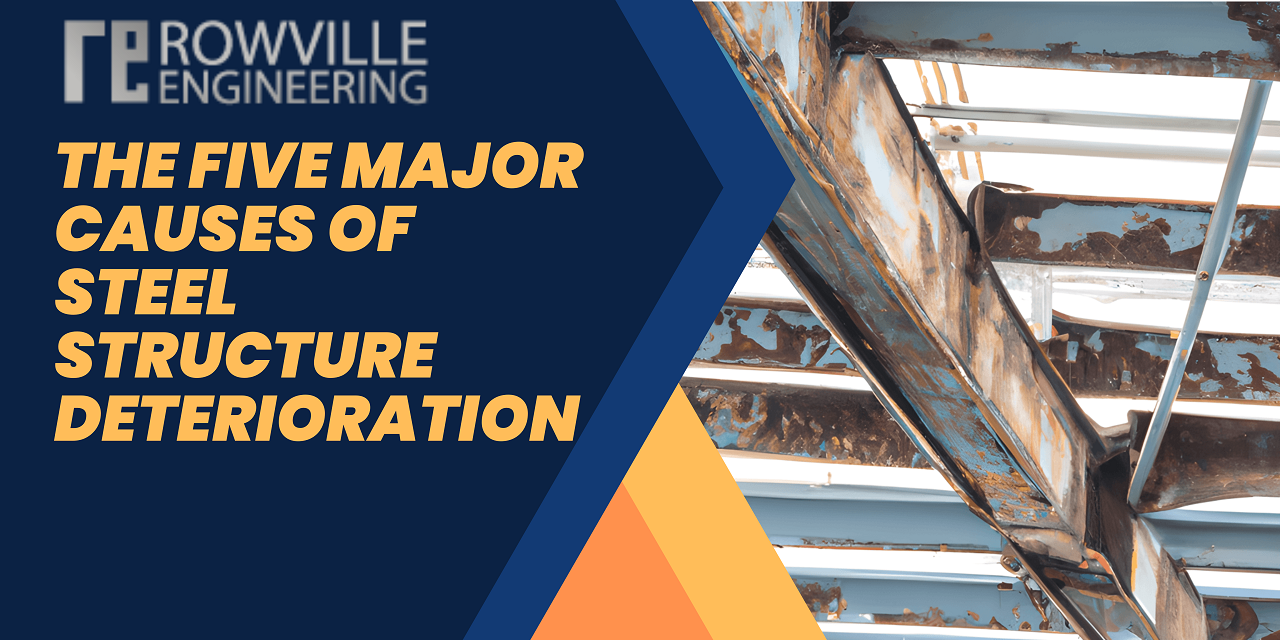The Five Major Causes of Steel Structure Deterioration
Steel structures are essential elements of any building project, from skyscrapers to houses to bridges. However, without careful attention, these structures can easily deteriorate and be rendered unusable in time. If you’re working on a construction project involving steel structures and want to avoid this hassle, here are the five major causes of steel structure deterioration and how to prevent them from happening.
Published On:13-03-2023

Environmental Conditions
Corrosion is the most common environmental cause of steel structure deterioration. It occurs when oxygen, water and other corrosive elements interact with metal, causing it to deteriorate. Corrosion can weaken the steel structure, making it more susceptible to damage and failure. To prevent corrosion, it is important to protect steel structures from moisture, chemicals and salt.
Ultraviolet (UV) light can also cause steel structure deterioration. UV light can cause paint to fade and corrode, weakening the protective coating that protects the steel structure from further corrosion. To minimize this issue, it is important to use protective coatings on steel structures to provide a barrier against UV light and other corrosive agents.
Rainwater can also contribute to the deterioration of steel structures. Rainwater can cause paint to peel and rust, leading to further damage to the steel structure. To prevent this, it is important to regularly inspect and maintain a steel structure’s waterproofing system..
Extreme temperatures can also lead to steel structure deterioration. High temperatures can cause metal components to expand and contract, leading to cracking and weakening of the structure. Low temperatures can also cause metal components to become brittle and prone to breakage. To minimize this issue, it is important to use materials that are resistant to extreme temperatures in order to ensure the structural integrity of a steel structure.
By understanding the environmental causes of steel structure deterioration, you can take steps to protect your structure from further damage. Investing in preventive measures such as corrosion protection, waterproofing systems and materials resistant to extreme temperatures can help keep your steel structures in good condition for years to come.
Inadequate Design
When designing a steel structure, engineers must take into consideration the type of environment the structure will be exposed to. Different materials used for the structure must be chosen to match the environment and function. The strength of the material must also be considered to ensure that it can adequately withstand the stresses that will be placed on it. Inadequate design can lead to premature failure due to inadequate material selection or inadequate calculations.
In addition, improper installation techniques can contribute to structural deterioration. If the assembly is not done correctly, the bolts may not be properly tightened, resulting in accelerated corrosion and structural failure. It is important to ensure that the assembly instructions are followed correctly and all bolts are tightened securely.
Finally, inadequate maintenance can also lead to structural failure due to corrosion. Regular inspections should be carried out to detect any areas of corrosion, which should then be treated immediately to prevent further damage. Furthermore, coatings should be applied to protect the steel from further corrosion. Proper maintenance can help ensure the longevity of the steel structure and prevent costly repairs down the line.
Poor Quality Materials
It is important to use high-quality materials when constructing a steel structure. This means ensuring that the steel is properly tested and certified by a reliable source and that it meets all applicable industry standards. Additionally, using materials with enhanced corrosion resistance can extend the life of the steel structure and reduce maintenance costs. Finally, be sure to keep an eye on the manufacturer’s recommended life cycle for steel structures, as this can be a useful tool for predicting how long a structure will last before needing repairs or replacement.
Inadequate Workmanship
The most common errors are misalignment of members, which can reduce the load-carrying capacity of the structure and cause premature fatigue failure. Poor weld quality can lead to a lack of structural integrity, which can reduce the strength of the structure and compromise its safety. Not to mention poor welding can also make it easier for corrosion to take hold in the joints.
Furthermore, improper installation or repair practices such as using the wrong type of bolts or nuts, not securing the bolts properly, or failing to install dampers can cause premature failure of a steel structure.
It is essential that all workers involved in fabricating, erecting, and maintaining a steel structure be trained in proper techniques and practices to ensure that these problems are avoided. Taking the time to ensure high-quality workmanship can save you time and money and keep your steel structure safe and reliable for years to come.
Lack of Maintenance
One of the most common causes of steel structure deterioration is a lack of maintenance. In many cases, this is due to a combination of factors, such as cost-cutting, complacency, or an underestimation of the importance of regular maintenance. Regardless of the cause, the result is often costly repairs or complete replacement.
Regular maintenance on steel structures is necessary to ensure that the structure continues to perform optimally and remains free from corrosion and other forms of deterioration. This includes inspecting the structure at least once per year, performing any necessary repairs or replacements, and regularly applying a protective coating. If these steps are not taken, the structure can begin to weaken and corrode over time, leading to significant damage.
It’s important to remember that regular maintenance doesn’t just help to prevent deterioration – it can also save money in the long run by reducing repair costs and extending the life of the structure. By making sure to keep up with routine maintenance, you can ensure that your steel structure will remain safe and sound for years to come.